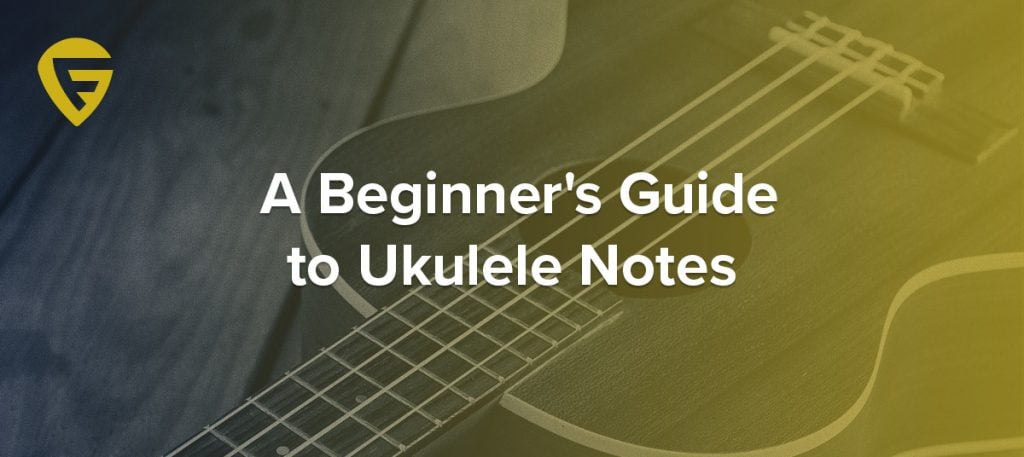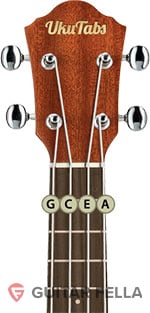- Home
- Instruments
- Gear
- Recording
- Lessons
- Reviews
- Blog

Newbie to the ukulele? Fear not, because in this article we’re going to take you through everything you need to know about ukulele strings and their notes.
While you don’t need to memorize every single note on the fretboard to start playing the ukulele, you should, at the very least, be able to identify the string names as a beginner.Otherwise, you’ll be scratching your head and reaching for a book / the internet every time you want to tune your ukulele, find a chord, or follow an instruction from a teacher.
To begin, all you’ll need is a decent ukulele and a little patience…
Note: In the following section we’ll be looking at the G-C-E-A tuning, which is standard on concert, soprano and tenor sized ukuleles – the sizes you should use if you are a beginner. If you are new to the ukulele you shouldn’t be using a baritone uke.

Let’s start with the string names, as this is fundamental for every ukulelist.
Begin by holding your ukulele in the conventional position. The top string – which is closest to you – is the G string. The next one down is the C string. The next string down is the E string. Finally, the furthest string away from you is the A string.
Using a mnemonic to remember the order is a good idea:
Go
Crazy
Every
Afternoon
Or use one you create yourself. Remember this order and you’ll find learning the ukulele will be so much easier.

Becoming an expert on the fretboard and instantly knowing where to find an A, a C or a G (or any other note!) comes with experience – the more you play, the easier it becomes to identify a note on demand.
Spend some time playing around with the open strings, as you learned above, then try to memorize the notes on all four strings up to the third fret. In this small ‘box’ you will be able to find every note you need – A, B, C, D, E, F and G.
As you’ll see in our image above, you start with a G by playing the G string open. The second fret of the G string is an A. The open C string will obviously give you an C, while the second fret on this string gives you a D. And so on.
Play around with the strings and the frets, and start to familiarize yourself with the notes by referencing the chart above.
If you’re wondering why some frets don’t have notes listed, this is because they are sharp or flat. You’ll get onto these eventually, but it’s not something to concern yourself with until you are comfortable with the regular notes.
A great way to learn the notes is to learn to play a scale. Sure, it’s not the most exciting thing you’ll ever do on a ukulele, but it’ll help you familiarize yourself with the notes on a fretboard.
For example, check out the C Major scale:

This basic scale is very simple to follow and, when you memorize it, finding notes will be simple. For the C Major scale, you will play the following notes in order: C, D, E, F, G, A, B and C again to finish.
If you aren’t sure how to read ukulele tab make sure to check out our dedicated guide, where we take you through everything you need to know.
For the C Major scale, begin by playing an open C string, then the second fret on that string for your D. Move to the E string and play that open for your E, then the first fret for an F, and the third fret for the G. Then move down and play an open on the A string for your A, then the second fret for the B and the third fret for the final C of the scale.
You can also familiarize yourself with the notes by playing the C Major scale on a single string, as we highlight in the image below:

In this example you only use the C string. Start by playing the open string for a C, then the second fret for a D, the fourth for an E, the fifth for an F… all the way up to the 12th fret on the same string, where you’ll finish the scale with your final C.
Playing the scale this way is much less efficient, but it gives you the opportunity to see how the notes work further up the fretboard. Give it a go.
Looking for an example of how to play a scale on the ukulele? Check out the video below which runs you through the C scale in detail in under five minutes:
Learning ukulele string names, notes, and scales can be a little boring – it’s certainly not the ultimate goal when pickup up your first ukulele.
However, when you start getting used to the notes you’ll realize it’s not as hard as you first assumed and will make you a better ukulelist in the long run. It’s simply a case of practicing, testing yourself, and then putting the notes to use in chords, scales and songs. Good luck!

Barbie Fajardo says
I’ve been learning Ukulele since last week. You are such a sweetheart! You’ve been teaching me so much, and this is really helpful. Thank you for your content.